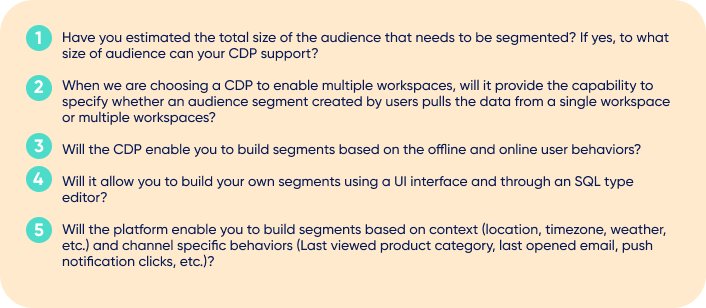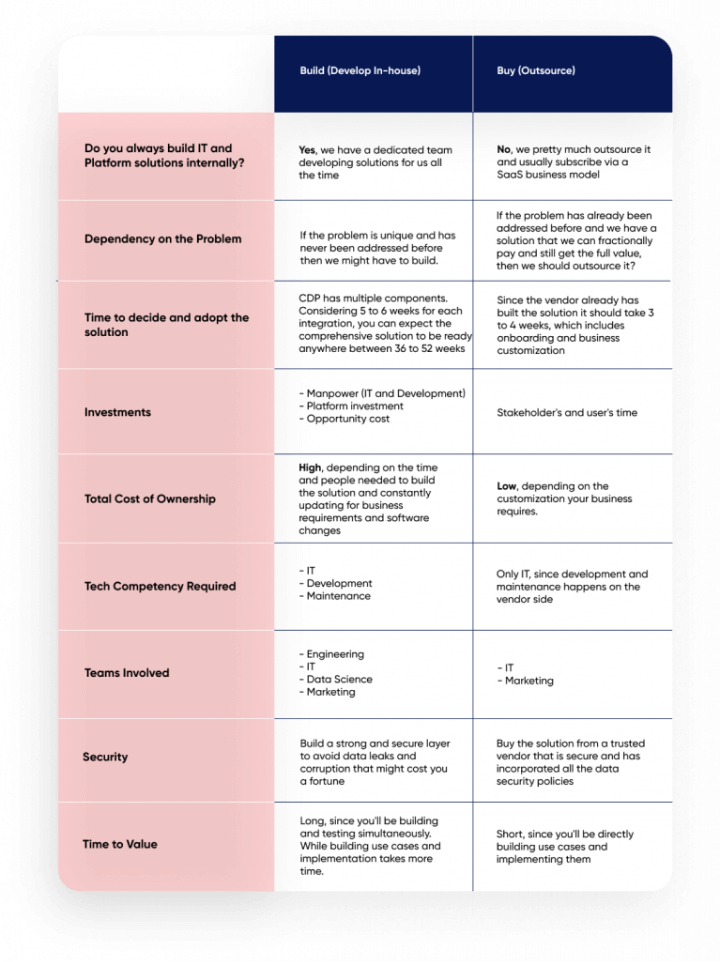How to choose the best Customer Data Platform
If you are looking to improve your businesses’ tech stack to know your customers better, build unified customer profiles, and deliver better customer experiences across all channels all in a single view, then it’s very likely that you need a customer data platform.
Since there’s a wide variety of CDPs in the market and they do not all fully deliver the capabilities of a customer data platform, we prepared a great question list for you to think about when choosing the right CDP for your needs.
Updated on Jul 9, 2022
What is a Customer Data Platform (CDP)?
A Customer Data Platform is a software system that allows you to unify your customer data across all channels. It also keeps data organized and makes it available to marketers to reach different business goals. But how do you choose the best customer data platform? What are the benefits of investing in one?
In short, unified data lets you know your customers on a deeper level to give them personalized experiences. As a result, CDPs can build customer loyalty and enhance customer relationships.
The main goals of CDPs:
- Unified Customer View: 360-degree visibility based on the customer’s behavioral data across channels.
- Segmentation: Grouping and targeting customers in an individualized way.
- Analyze: Providing customer data insights to different parts of your business.
- Advertise: Boosting advertising campaigns by predictive segmentation capacities, greatly improving Return On Ad Spend (ROAS).
- Real-Time Personalization: Delivering highly relevant, personalized customer journeys in real time across all channels.
- Enhance your CRM (customer relationship management software): Providing a single, consolidated view of customer data in one central data warehouse.
CDP components
CDP is a key piece of your data infrastructure. It maintains and processes your most valuable assets, customer data. As a result, many businesses consider building a custom CDP solution. However, before we dive into building or buying a CDP, let’s look at the 5 components of a CDP:
- Data connectors
- Profile unification
- Segmentation
- Audience activation
- Analytics
Data Connections
In order to build a unified customer profile and deliver an omnichannel experience, CDPs must be able to collect first-party and third-party data, online and offline data, as well as leverage other data sources such as mobile apps, websites, OTT devices, systems, and applications, via native SDKs, API connections, and webhooks.
After all, delivering a consistent customer experience, personalized recommendations, and tailored messages require different types of data. What’s more, customers have many digital touchpoints and paths to purchase your product.
Let’s say you have customers who purchase products from you on various channels (multi-channel shoppers). On the other hand, there are customers who have adopted the click and collect model (hybrid shoppers). Unfortunately, this data is scattered across multiple channels and becomes hard to collect, organize, and unify.
Hence, it is important to have data connectors to help you collect data from various sources in real time.
Here are the key questions you should ask while evaluating this component:

Profile unification
Once all your data is ingested into the platform it needs to be tied to build unique customer profiles that can be easily accessed from within a UI. Now, this can be done programmatically using a REST API. These profiles should contain events, attributes, device information, user consent, and more.
Since you operate on multiple engagement channels, you will be tracking users with different kinds of identities (identifiers). However, all the user events need to be unified to respective customer profiles. Note: customer profiles will be compromised if the data ingested isn’t accurate or consistent.
Here are the key questions you should ask while evaluating this component:

Segmentation
One of the key functions of Customer Data Platforms, especially for marketing teams, is centralized audience segmentation. A CDP should provide segmentation capabilities within the user interface (UI). These should make it easy for non-technical users to build audience segments with any customer-associated data you’ve collected.
Developing a segmentation engine can get complex when building your own CDP. As data becomes more accurate so does segmentation with much greater data accuracy. And a more accurate segmentation such as RFM segments and tactical segments such as “All women shoppers who purchased a red dress in the last 14 days” becomes an integral part of your targeting strategy.
Here are the key questions you should ask while evaluating this component:

Audience Activation
Once you have your segments ready, you need to put this audience data to use by activating them across multiple channels. 3rd-party integration connections make it possible to get the customer data out of the CDP. The connections that a CDP has, as well as the type of integration built for each connection, depend on the CDP use cases. In order to activate your audience through different channels in real-time, you need respective APIs.
Here are the key questions you should ask while evaluating this component:

It is important to consider the integration needs for different channels over time. With this you need to ensure the following things:

Analytics
Once you’ve engaged your audience it is crucial to your outbound marketing efforts. It critical to get customer insights to understand how they will behave. Doing so, will help you engage with customers at the right time, with the right message.
The more you understand your customers’ behavior, preferences, and buying habits, the more accurate your predictions of future purchase behaviors will be – and the more successful you will be at engaging them with individualized and contextual messages that turn ‘at risk’ customers into ‘active and loyal’ customers.
Hence having an analytics suite to measure the efficacy of your marketing campaigns. It also plays a crucial role in deriving data and insights from your customer’s interactions from different channels and also enriching your existing customer data.
It is important to consider the integration needs for different channels over time. With this you need to ensure the following things:

5 Steps To Choosing A Customer Data Platform
When choosing a CDP, you should consider a few things. The first is to understand whether you need such a platform or not. Please refer to our previous blog that details how to determine if you need a CDP.
An in-depth analysis of your business objectives, as well as the needs across different departments and stakeholders in your business, should be considered before selecting a specific CDP vendor.
You should also answer how you’ll benefit from having a persistent and unified customer database. So are some fundamental questions to consider:
- What is your overall digital marketing strategy and how does it relate to your business goals?
- What gaps exist in your current tech stack and program?
- In what way do you see a Customer Data Platform fitting into your current marketing stack and team?
- Do you have any specific preferences when it comes to CDPs?
- What would success look like to you with this new platform in place?
Keep in mind: Consult and communicate with the teams that will benefit from CDPs.
People who use a CDP daily can provide detailed answers and guide you in the right direction.
Discover the power of Insider — explore our interactive product demos now.
Should I build or buy a CDP?
Now that you know the 5 components of a CDP, your next adventure is:
- To build your own CDP (develop in-house)
- To buy a CDP/partner a CDP vendor (outsource)

Use this table to simplify the decision-making process around building or buying a CDP
In the age of individualization, CDPs are one of the most effective marketing technology platforms for empowering data-driven marketers.
Enterprises and startups looking to engage the services of a Customer Data Platform vendor often consider partnering with one of the leading vendors. The result has been several benefits, including 3 of the following:
Time to Value
One of the biggest benefits you get when you partner with a CDP vendor is faster time to value, the speed at which you can have it up and running. By integrating packaged SDKs into your digital properties or setting up API connections, you do not have to dedicate valuable resources to building your own CDP.
In addition, CDP vendors may provide professional services to assist your engineers with implementation. From the initial briefing call to execution, Insider can help you complete the process within 90 days or less.
Cost
An investment in a leading Customer Data Platform vendor can be cost-effective. Developing a CDP internally is expensive. It requires time and resources from developers and engineers. It also requires alignment across the entire organization for an extended period of time. Whenever there is a delay with the building process, the project will end up costing more. In contrast, a CDP vendor will offer all the capabilities your team needs at a specific subscription cost.
Ease of use
Data can be gathered from a variety of sources. Such as a POS system, with little-to-no engineering dependency. In addition, limited data sets can be sent in a few clicks to teams or to A/B test platforms.
Customer Data Platforms (CDPs) have become increasingly popular in recent years. Today, data has a direct correlation to improved customer experience and better customer relationships. Data also plays a role in customer engagement. Especially, since well-engaged customers drive higher revenue and positive business growth.
Final thoughts on the best customer data platform
In truth, Customer Data Platforms have become increasingly popular in recent years.
According to CDP Institute’s Industry Update, the number of CDP vendors has more than quadrupled in 2.5 years (between Dec 2016-June 2019). Additionally, buyer interest in omnichannel marketing, data optimization, and customer journey orchestration is on a steady rise.
Today, data has a direct correlation to improved customer experience. In turn, better customer relationships amplify engagement and loyalty. Eventually, that turns into higher revenue and deeper customer investment.
By accessing high-quality customer data, CDPs allow non-technical teams like marketing to perform data-driven tasks. This helps them further understand their customer journeys, execute targeted personalization campaigns, and improve the product experience. Thus, a customer data platform (CDP) is a must-have and a critical part of a business’s modern data infrastructure.
To learn more about Insider’s CDP and its capabilities, you can schedule a demo with one of our product experts.



















